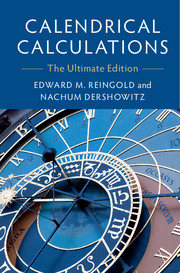Book contents
- Frontmatter
- Dedication
- Contents
- List of Frontispieces
- List of Figures
- List of Tables
- List of Calendar Functions
- Abbreviations
- Mathematical Notations
- Preface
- Credits
- License and Limited Warranty and Remedy
- 1 Calendar Basics
- I Arithmetical Calendars
- II Astronomical Calendars
- 14 Time and Astronomy
- 15 The Persian Calendar
- 16 The Bahá’í Calendar
- 17 The French Revolutionary Calendar
- 18 Astronomical Lunar Calendars
- 19 The Chinese Calendar
- 20 The Modern Hindu Calendars
- 21 The Tibetan Calendar
- Coda
- III Appendices
- References
14 - Time and Astronomy
from II - Astronomical Calendars
Published online by Cambridge University Press: 22 March 2018
- Frontmatter
- Dedication
- Contents
- List of Frontispieces
- List of Figures
- List of Tables
- List of Calendar Functions
- Abbreviations
- Mathematical Notations
- Preface
- Credits
- License and Limited Warranty and Remedy
- 1 Calendar Basics
- I Arithmetical Calendars
- II Astronomical Calendars
- 14 Time and Astronomy
- 15 The Persian Calendar
- 16 The Bahá’í Calendar
- 17 The French Revolutionary Calendar
- 18 Astronomical Lunar Calendars
- 19 The Chinese Calendar
- 20 The Modern Hindu Calendars
- 21 The Tibetan Calendar
- Coda
- III Appendices
- References
Summary
Ask my friend l'Abbé Sallier to recommend to you some meagre philomath, to teach you a little geometry and astronomy; not enough to absorb your attention, and puzzle your intellects, but only enough, not to be grossly ignorant of either. I have of late been a sort of an astronome malgré moy, by bringing last Monday, into the house of Lords, a bill for reforming our present Calendar, and taking the New Style. Upon which occasion I was obliged to talk some astronomical jargon, of which I did not understand one word, but got it by heart, and spoke it by rote from a master. I wished that I had known a little more of it myself; and so much I would have you know.
Letter from Philip Dormer Stanhope (Fourth Earl of Chesterfield) to his son, February 28, 1751 c.e. (Julian)The calendars in the second part of this book are based on accurate astronomical calculations. This chapter defines the essential astronomical terms and describes the necessary astronomical functions. A fuller treatment can be found in the references—an especially readable discussion is given in [14].
We begin with an explanation of how the positions of locations on Earth and of heavenly bodies are specified, followed by an examination of the notion of time itself. After discussing the 24-hour day, we summarize the different types of years and months used by various calendars along with algorithms that closely approximate the times of astronomical events—notably equinoxes, solstices, and new moons. These astronomical functions are adapted from those in [18] and [4] and require 64-bit arithmetic.
Most of the algorithms are centered around the present date, for which they are accurate to within about 2 minutes. Their accuracy decreases for the far-distant past or future. More accurate algorithms exist [3] but are extremely complex and not needed for our purposes.
Chapter 18 applies the methods of this chapter to several “speculative” astronomical calendars.
Position
The cause of the error is very simple … In journeying eastward he had gone towards the sun, and the days therefore diminished for him as many times four minutes as he crossed degrees in this direction. There are three hundred and sixty degrees in the circumference of the Earth; and these three hundred and sixty degrees, multiplied by four minutes, gives precisely twenty-four hours—that is, the day unconsciously gained.
- Type
- Chapter
- Information
- Calendrical CalculationsThe Ultimate Edition, pp. 203 - 256Publisher: Cambridge University PressPrint publication year: 2018



